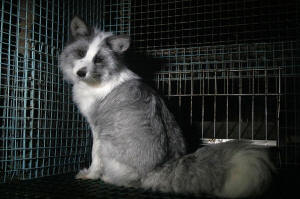Activists release images of foxes at Finnish fur farms to push EU to ban
the trade
 Send a link to a friend
Send a link to a friend
 [December 16, 2024] By
JAMEY KEATEN [December 16, 2024] By
JAMEY KEATEN
GENEVA (AP) — A red fox frantically scratches the wires of its small
cage. An Arctic fox meanders lazily with a bloody tail. Other furry
creatures, some with teary eyes, stare blankly into a light on an
activist's video camera.
Finnish advocacy group Oikeutta Elaimille, or Justice for Animals, and
Humane Society International have released images taken from an
“undercover investigation” at three fur farms in western Finland in late
October to highlight the behind-the-scenes realities of the trade.
The activists’ incursion came as the European Union, which counts
Finland as a member, is awaiting advice in March from the EU agency that
oversees animal welfare before deciding in March 2026 whether it should
propose a ban on fur farming altogether.
FIFUR, a Finnish fur-breeders group, blasted the “covert filming” of the
farms, accusing the intruders of “breaching strict biosecurity
requirements” on farms where operations are “strictly controlled by
national laws and regulations” and where veterinarians monitor animal
welfare.
Some viewers might ache over the conditions of the cuddly-looking
creatures; others might wonder what the big deal is: The industry is —
at least for now — legal and regulated.
Aside from the animals’ captivity in small cages — with sometimes more
than one in a single cage — none of the images shows abuse in progress.
No explanation was given for the bright red blood on what looked like an
open gash and exposed bone in a single Arctic fox’s tail area.

“These pictures and these intrusions ... it creates a false image of
normal lab animal welfare and animal keeping in the farms," said FIFUR
spokesman Olli-Pekka Nissinen, adding that his group believed the
initiative to ban fur farming will be rejected.
The breeders' group said the fur sector has among the highest welfare
standards of any form of animal husbandry, and Nissinen suggested that
farmers have little incentive to mistreat them. "Animal welfare first
shows in the animals’ fur and it’s very important for farmers to take
care of the animals so that they can have decent incomes.”
FIFUR says most of its 442 member farms — as of December last year — are
run by family businesses, and nearly all the farms are in the
Ostrobothnia region along the Baltic Sea. Finland is the world's largest
producer of certified fox pelts, the industry group said.
Oikeutta Eläimille spokesman Kristo Muurimaa says the operation involved
entering the farms to observe and document the conditions in which the
animals are kept and that the photos were taken in compliance with
Finnish law.
Neither side has announced plans for any legal action.
“Fur has been used by people for a long time, since the Stone Ages
basically," Muurimaa said. “However, a practice where animals are kept
in very small barren cages is not that old. It is a product of modern
times where animals are seen just as products.”
[to top of second column] |

This photo provided by Humany Society International shows a fox
inside a cage at a fur farm in western Finland, in late October,
2024. (Humany Society International/Oikeutta Elaimille via AP)
 “This kind of treatment of animals
doesn’t belong to this day. Times have moved on and now it’s time to
leave this kind of cruelty behind,” he added. “Nobody needs fur in
modern times. Fur is mostly used as a status symbol by the rich
elite in countries like China and Russia.”
The 27-country EU, according to its most recent figures, estimates
about 1,000 fur farms with roughly 7.7 million animals — including
mink, fox and raccoon dogs — are active in the bloc.
In neighboring Switzerland, which is not an EU member, a three-month
public consultation ended last month on a government proposal to ban
the import and sale of furs drawn from the “mistreatment” of
animals. The measure would allow authorities to seize such furs.
Activists want the Swiss government to go further, seeking a broader
definition of “mistreatment” and wider range of fur farms affected.
The issue, currently low on Switzerland's full referendum calendar,
could be put to a public vote in late 2026 at the earliest.
Humane Society International, in a statement last month, said tens
of millions of animals suffer and die each year in the global fur
trade and the “vast majority of animals killed for their fur are
kept in barren battery cages on fur farms.”
Finland, the advocacy group said, is one of the last European
countries where farming such animals for their fur remains legal —
and finger-pointed a number of retail brands that use fox fur from
Finland.
China is the world's most important export market for furs, followed
by South Korea and the Western Europe-North American market, said
FIFUR, which counts hundreds of farms in Finland as members.
In Europe, as of 2023, Poland and Greece were the biggest producers
— almost entirely from mink — while Finland is third, according to a
report by the industry association this year.

Bird flu and coronavirus outbreaks hit the fur industry hard,
notably in Denmark, since 2020, but the trend line in supply has
been declining for many years.
FIFUR's report showed supply volumes of mink pelts plunged by
roughly three-quarters since 2010 — to 12,285 last year — a similar
percentage decline to that for mink pelts, which totaled 2,440 in
2023.
All contents © copyright 2024 Associated Press. All rights reserved |